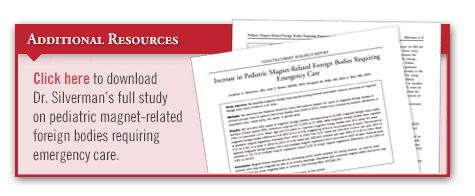Studies have documented an increase in the number of magnet-related injuries in children involving the alimentary and respiratory tracts as well as the nasal, ear, and genital areas. Ingesting multiple magnets or magnets together with metal objects can severely damage intestinal walls to the point that emergency surgery may be necessary.
“Children commonly put things in their mouth and nose, but the risk of intestinal damage increases dramatically when multiple magnets are swallowed,” says Jonathan A. Silverman, MD. Among magnet-related injuries in children, ingestions are the most common in the United States. However, investigations exploring the epidemiology and trends of single and multiple magnet-related ED visits by children in the U.S are lacking.
Characterizing the Problem
Dr. Silverman and colleagues had a study published in Annals of Emergency Medicine that used data from the National Electronic Injury Surveillance System to assess current trends in cases of magnetic foreign bodies found in children. The study sample included children younger than age 21 in the U.S. with 22,581 magnetic foreign body injuries from 2002 to 2011.
The incidence of magnet ingestions requiring emergency care was higher than what has been previously reported in clinical research. Between 2002 and 2003, the estimated incidence of injury was 0.6 cases per 100,000 children in the U.S., but this jumped to 3.1 cases between 2010 and 2011. Most ingested magnetic foreign bodies and multiple magnet ingestions occurred in 2007 or later.
“Children commonly put things in their mouth and nose, but the risk of intestinal damage increases dramatically when multiple magnets are swallowed.”
The study also revealed that most magnetic foreign bodies were ingested (74%) or intranasal (21%). For cases in which children ingested multiple magnets, almost 16% were admitted to the hospital. “The magnets in question were typically those found in kitchen gadgets or desk toys that are marketed to adults,” adds Dr. Silverman. “The injuries were not restricted to small children; there were proportionally more nasal injuries involving older children. This could be due to magnets being increasingly used to imitate nose, tongue, lip, or cheek piercings. Parents need to be aware of the serious risk that these magnets pose if they’re swallowed.”
Need for Greater Awareness
Increasing awareness of the costly, serious, and potentially fatal consequences of magnet ingestions in children is important to reducing the burden of these occurrences, says Dr. Silverman. “Clinicians who care for children and teens need to be aware of the risks associated with magnet ingestions. When evaluating children with abdominal pain, we need to be proactive and ask specific questions about ingestions. When multiple magnets have been ingested, it’s critical to evaluate patients quickly, image them appropriately, and consult with gastroenterology or surgical colleagues promptly. Parents should be counseled to remove loose magnets from fridges, bulletin boards, and desktops. They should also teach their children and teens never to put magnets in or near their mouths.”




 admin
admin